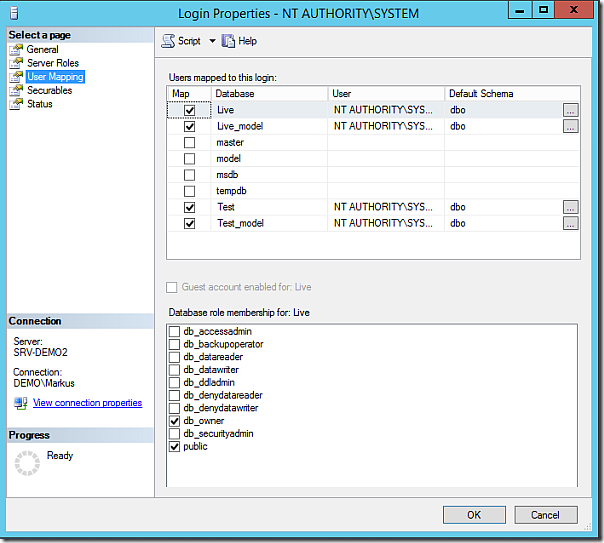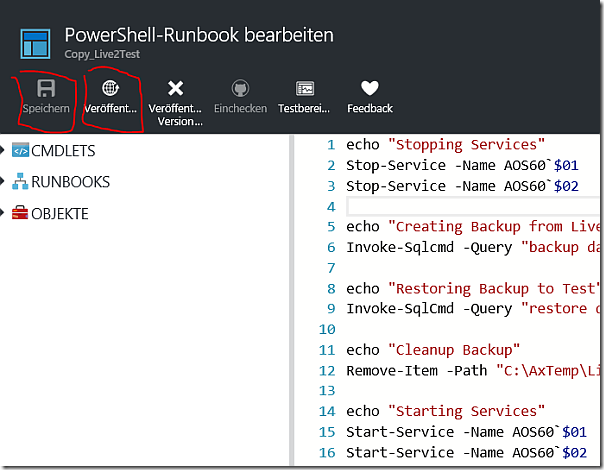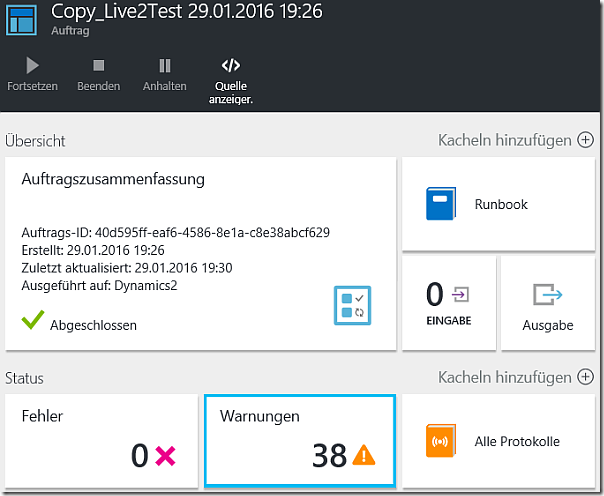Updating the Test system with actual transactional data from the Live system is a common task. This can be accomplished using scripts. However, in a hybrid IT environment you might want to organize, manage and monitor all your on-premises and cloud based scripts at a central place. Azure Automation is the platform to do this.
Prerequisites
- Dynamics AX Live and Test installation on Windows Server 2012 R2
- Azure Account (all services can be used for free in basic mode)
Azure Automation
In Azure Portal create a new instance of Azure Automation. When the instance was created, use the key to display the keys and URL. You’ll need this to connect your on-premises server with Azure Automation.
Operational Insights
Azure Automation can be instantly used to script your cloud-based datacenter. However, to manage the on-premises environment you have to connect your local systems with the cloud. This is done via Operational Insights.
- In Azure Portal create a new instance of Operational Insights
- Logon to Operational Insights Portal and start the “Get Started” checklist
- Add the Automation Solutions
- Connect the Dynamics AX server by downloading and installing the Agent for Windows
At your on-premises server open PowerShell in admin mode and go to the agents installation directory e.g.
cd "C:Program FilesMicrosoft Monitoring AgentAgentAzureAutomation<version>HybridRegistration"
Import the Hybrid Registration module and register the server in Azure Automation.
Import-Module HybridRegistration.psd1
Add-HybridRunbookWorker –Name <String> -EndPoint <Url> -Token <String>
In this example I’ve used the Name parameter value “Dynamics” at the Add-HybridRunbookWorker Cmdlet. This creates a runbook worker group called “Dynamics” with one assigned on-premises server.
On-Premises configuration
Create a folder where to backup the Dynamics AX database. In this example I’m using a directory on the local system drive C:AxTemp (which of course is not best practice). By default the Ops. Insights Agent runs as Local System. Make sure to give the account “NT AuthoritySystem” appropriate rights in your SQL Server installation to access the Live DB and Test DB.
Runbook
In Azure Portal, go to Azure Automation > Runbooks > Create a new runbook > Choose runbook type “Powershell”. Add the following code to your runbook.
echo "Stopping Services"
Stop-Service -Name AOS60`$01
Stop-Service -Name AOS60`$02
echo "Creating Backup from Live"
Invoke-Sqlcmd -Query "backup database [Live] to Disk = N’C:AxTempLive.bak’ with copy_only" -QueryTimeout 0
echo "Restoring Backup to Test"
Invoke-SqlCmd -Query "restore database [Test] from DISK = N’C:AxTempLive.bak’ with file = 1, move N’R3Demo1‘ TO N’C:DataTest.mdf’, MOVE N’R3Demo1_log‘ TO N’C:DataTest_log.ldf’" -QueryTimeout 0
echo "Cleanup Backup"
Remove-Item -Path "C:AxTempLive.bak"
echo "Starting Services"
Start-Service -Name AOS60`$01
Start-Service -Name AOS60`$02
This will stop both AOS instances. Make sure the AOS service name fits your environment. The service name can be found in the services mmc. For example my Live AOS is named AOS60$01. Make sure to use the ` to escape the $ sign in the AOS name.
The script will then create a backup from database “Live” to C:AxTempLive.bak. If your live DB has another name, change it to fit your name.
Next the script will restore the backup to database “Test”. In my case the logical name of the database file is called “R3Demo1” and it’s log is called “R3Demo1_log”. Make sure this fits your installation. You can find the names in SQL Server management studio, by checking the database file properties.
Finally the script removes the backup file and restarts both AOS
Runbook Execution
In Azure Automation Runbook editor, save the actual runbook code and click publish.
At the Azure Automation main page go to runbooks, select your newly created runbook and press the start button. On the next page select execution using a Hybrid Worker and select your worker group. In my example it’s called Dynamics (see PowerShell screenshot)
This will submit your runbook to the on-premises server and execute it. You can check the execution by monitoring the C:AxTemp directory where the backup will be placed. Don’t worry about the warnings when the workbook finishes. Starting the AOS’ takes a while and results in the typical message “service is not responding”.
More
- Azure Automation supports timing of runbooks, so you can create a batch in the cloud to copy your data on-premises
- This example uses a single server installation. However, the script can easily be modified to run on different servers
- Using the Invoke-SqlCmd Cmdlet you can do all the cleanup work like changing the reporting server instance etc.








